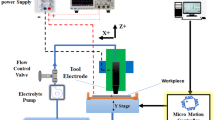Abstract
Micro-deep drawing process combined with ultrasonic vibration were performed on three stainless steel 304 foils of different thicknesses to determine the influence of ultrasonic vibrations on micro-cup formability and the limit drawing ratio (LDR). An ultrasonic system that applies 20 kHz of oscillation at various amplitudes was developed, and a concentrator was used to transfer the oscillation from the transducer to the die. The LDRs of these foils were obtained with and without ultrasonic variations. The experimental results in this study showed that using ultrasonic vibration following the deep drawing processes increased the LDR from 1.67 to 1.83, from 1.75 to 1.92, and from 1.83 to 2 for thicknesses of 50, 75, and 100 μm, respectively. The oscillation amplitudes had a significant effect on different thicknesses. An amplitude of 8.6 μm could not be appropriately applied to foils because of the excessive oscillated force. The punch force also decreased as the oscillation amplitude increased because of reduced friction between the die and the blank. Based on these experimental results, this study showed that ultrasonic vibrations can be used to produce micro-cups that exhibit high application flexibility in miniaturization technology.
Similar content being viewed by others
References
Tseng HC, Hung CH, Huang CC (2010) An analysis of the formability of aluminum/copper clad metals with different thicknesses by the finite element method and experiment. Int J Adv Manuf Technol 49:1029–1036
Chamekh A, BenRhaiem S, Khaterchi H, BelHadjSalah H, Hambli R (2010) An optimization strategy based on a metamodel applied for the prediction of the initial blank shape in a deep drawing process. Int J Adv Manuf Technol 50:93–100
Özek C, Bal M (2009) The effect of die/blank holder and punch radiuses on limit drawing ratio in angular deep-drawing dies. Int J Adv Manuf Technol 40:1077–1083
Mostafapur A, Ahangar S, Dadkhah R (2013) Numerical and experimental investigation of pulsating blankholder effect on drawing of cylindrical part of aluminum alloy in deep drawing process. Int J Adv Manuf Technol 69:1113–1121
Gau JT, Teegala S, Huang KM, Hsiao TJ, Lin BT (2013) Using micro deep drawing with ironing stages to form stainless steel 304 micro cups. J Manuf Process 15:298–305
Saotome Y, Yasuda K, Kaga H (2001) Microdeep drawability of very thin sheet steels. J Mater Process Tech 113:641–647
Vollertsen F, Hu Z, Schulze Niehoff H, Theiler C (2004) State of the art in micro forming and investigations into micro deep drawing. J Mater Process Tech 151:70–79
Gong F, Guo B, Wang CJ, Shan DB (2010) Effect of lubrication conditions on micro deep drawing. Microsyst Technol 16:1741–1747
Wang CJ, Guo B, Shan DB, Bai XM (2013) Experimental research on micro-deep drawing processes of pure gold thin sheet using DLC-coated female die. Int J Adv Manuf Technol 67:2477–2487
Chen CH, Gau JT, Lee RS (2009) An experimental and analytical study on the limit drawing ratio of stainless steel 304 foils for microsheet forming. Mater Manuf Process 24:1256–1265
Blaha F, Langenecker B (1955) Tensile deformation of zinc crystal under ultrasonic vibration. Naturwissenschaften 42:556
Pasierb A, Wojnar A (1992) An experimental investigation of deep drawing and drawing process of thin-walled products with utilization of ultrasonic vibrations. J Mater Process Tech 34:489–494
Jimma T, Kasuga Y, Iwaki N, Miyazawa O, Mori E, Ito K, Hatano H (1998) An application of ultrasonic vibration to the deep drawing process. J Mater Process Tech 80–81:406–412
Bunget C, Ngaile G (2011) Influence of ultrasonic vibration on micro-extrusion. Ultrasonics 51:606–616
Author information
Authors and Affiliations
Corresponding author
Rights and permissions
About this article
Cite this article
Huang, Y.M., Wu, Y.S. & Huang, J.Y. The influence of ultrasonic vibration-assisted micro-deep drawing process. Int J Adv Manuf Technol 71, 1455–1461 (2014). https://doi.org/10.1007/s00170-013-5553-1
Received:
Accepted:
Published:
Issue Date:
DOI: https://doi.org/10.1007/s00170-013-5553-1




